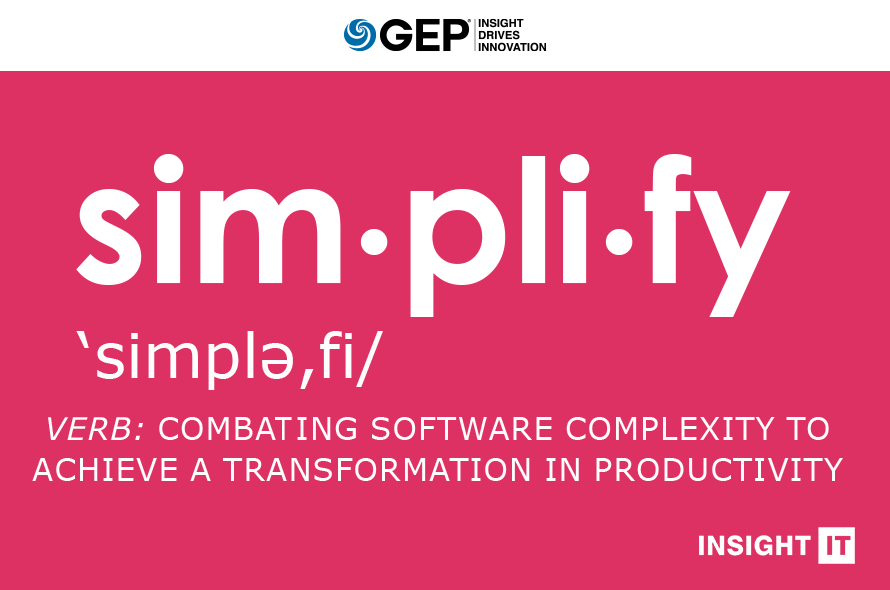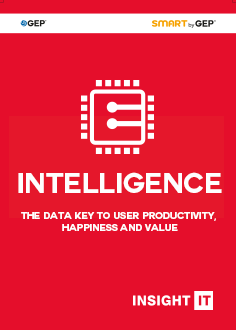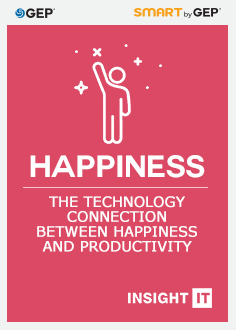Is simple always better? And if so, how simple? It’s already understood that unnecessary complexity is counterproductive and undesirable, but then so is oversimplification. After all, too much of a good thing can be a bad thing.
In the development of business software, this is a frequent conundrum. When the underlying process is an intricate one, can the technology be easy to use and still retain the necessary features to perform effectively? In essence, can simplicity and complexity (usability and functionality) coexist in the same software system?
Our new Insight IT piece, “Simplify: Combating Software Complexity to Achieve a Transformation in Productivity,” identifies three crucial aspects of digital strategy that CIOs can target for simplification to boost workplace acceptance without sacrificing functionality. Read it today — it’s got some simple advice for addressing this complex problem.
There's a famous quote usually attributed to Albert Einstein: “Everything should be made as simple as possible, but not simpler.” We can extrapolate from this that it's desirable to keep even complex things as simple as they can be — but not so simple that vital information or features are lost. Simple is good. Oversimplified, not so much.
It's easy to think of “simple” as a synonym for “basic” or “less sophisticated.” We tend to assume that something that's easy to use or understand may not possess the power to solve complex problems or deal with matters of higher difficulty. But this is a common misconception — simple and uncomplicated doesn't necessarily have to mean rudimentary, stripped down or minimal, because sophistication (or inherent complexity) can very well reside beneath the simplicity. In fact, that's precisely how the notion of simplicity must be applied to best effect.
When placed in the context of business software, what this means is that simplification and the removal of complexity, coupled with the retention of essential functionality, can make it much easier to drive adoption and realize productivity gains.
The Dangers of Complexity
When organizations are looking for transformation — a radical upgrade in capability and key processes, and a new level of output — they need to break free of any limitation to productivity. In this situation, complexity is the enemy, and the most effective use of simplicity is fighting complexity.
Complexity is dangerous for organizations that are striving to grow and be more competitive. When confronted with complex, user-unfriendly tools, users' morale drops. They feel simultaneously unsupported by their leadership and personally lacking in competence. They feel frustrated with their inability to complete tasks quickly and efficiently. And worse — they get used to things being that way. It becomes “normal” to incur days of delay because someone hit a technological roadblock, and delegated the problem to someone else, who then took the problem to IT, and waited for IT to respond, and then took the solution back to the original user. It becomes “normal” to just abandon various technological tools (thereby writing off the investment) in favor of simpler but less efficient work-arounds.

Although the actual work being performed may be complex, the way of doing it does not have to be complicated. The pivotal difference is in the ability to perform a difficult task easily, versus having to negotiate avoidable intricacies to do it.
Plainly put, simplicity should be used to transform arduous, stultifying, and exasperating tasks or experiences into seamless, interesting and rewarding ones.
Good Software — Simple by Design, Complex in Functionality
If software is going to be well received and widely adopted, it has to make its own case — embodying a genuine “reason to exist” strong enough to persuade even the most obstinate users that they are better off using it, rather than making do without it. To achieve this, the software must first convince the user of its utility and prove that it can indeed make things easier for them. Again, the emphasis here is on simplicity.
Good software should be easy to learn and operate. It should be intuitive, responsive and visually pleasing at the surface level. But at the same time it must contain all the features necessary to perform the user’s most difficult tasks more efficiently and with added ease. So it has to incorporate complexity — but the complexity of its functionality must be subservient to user experience design, which in turn must prioritize simplicity: a clean interface, the right number of features (not too many, not too few), and the fulfillment of each of the user’s needs in the most straightforward way possible

Simplifying Everything
A successful digital strategy is one in which every aspect is made simple, easy, uncomplicated: processes, data and the user experience.
At every level, from data acquisition, presentation, planning and workflow to reporting, outcome and measurement, IT should focus on reducing the burden on the user to just the essentials. We discussed pertinent points of this strategy in several of our other INSIGHT IT articles.
Simplify the process: The end-to-end process itself needs to be made shorter, easier and more streamlined. Processes today are often overblown and excessively complex because of the software that is used. For example, duplication of effort and data and/or use of disconnected systems makes the whole process lengthy and laborious. If the process is reengineered to be shorter and more efficient, it will determine the technology most suited for the purpose.
Simplify the access to, and understanding of, data: Converting raw data into easily understandable, actionable information can enable users to fight the complexity otherwise inherent in most businesses today. Enabling cross-functional connectivity and information accessibility can turn data into a tremendous competitive advantage for the business.
Simplify the user experience: A business software system that offers a well-designed, easy-to-use user interface (UI) and an engaging user experience (UX) can quickly translate into greater user acceptance, adoption and productivity. High usability equals fewer training hours, lesser skill and effort to learn, and a digital workplace filled with happier, more productive users.
Conclusion
The first principle in the quest for greater simplicity in software design should be this: Don’t mistake simplicity for “dumbing down” the product. Too much simplicity is not necessarily the best way to engage the user. The best software prioritizes an understanding of its users and what they are specifically trying to achieve. It’s crafted with knowledge of who its users are, how they will be using the product, and how the product should be simplified to their needs — not for the sake of simplification itself.




